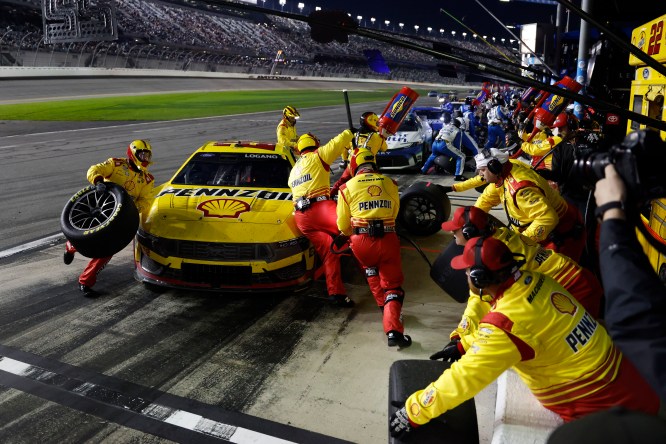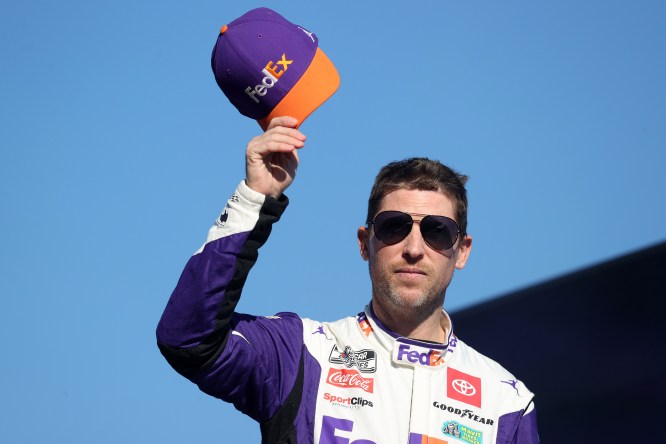
Kyle Busch did not enjoy spending a majority of the Daytona 500 at partial throttle in the name of fuel conservation.
In fact, he absolutely hated it, and called it a problem.
“The start of the race, we were all sitting around running half-throttle, not passing and just riding in a line,” Busch said. “I felt disgraceful, myself, being a race car driver, wanting to go fast, lead laps and win the Daytona 500 and that was our strategy that we had to employ at the start of the race because everybody was doing it.”
Track position is what factored into the strategy.
The goal is to spend as little time on pit road because if you need less fuel than those who burned more fuel over the previous stint, a team can effectively flip the field and come off pit road near the front and with a chance to score maximum points at the end of the stage.

Remember, the winner of each stage scores a playoff point and the top-10 at the end of the first two stages score up to 10 points.
Hamlin says NASCAR has to get the cars spread out a little bit more.
“Right now, you can be 30th and only a second behind the leader and just sit in this big ole back and save fuel, and then those cars can jump ahead, where in the old days, handling was more of a factor and the cars were not as easy to,” he paused before choosing his next words.
“It’s much harder now to navigate driving to the front so everyone is trying to do it through strategy.”
Joey Logano says it felt like the Tour de France.
“Everyone was in this Peloton and a couple of runners take off and you’re like, ‘What are they doing? Why are they doing that,’ trying to drag the pack along and get them up to speed and then everybody did kind of get up to speed after that,” Logano said. “It’s a different strategy. It’s interesting. It’s a different way of racing.
“It’s still a race. It’s still part of the race it’s just a different way of doing it and it’s up to everybody in this room to really educate the fans on what this next step is and why we’re doing it. As much as we want to say we want to run 100 percent all the time, it’s all well and good, but there’s also just a strategy race that sometimes is pretty interesting.”
But behind the wheel, Busch said the process felt emasculating as a race car driver, who is typically tasked with going as fast as possible.
“When you’re running wide open and you’re in the draft, your pace is probably a 46.30,” Busch said of Daytona 500 lap times. “We were running 49.80’s, almost 50 second lap times. It was pathetic. I was like, how slow are we going to go?
“I felt bad for the fans. This is not good for them. It’s not what I want to be doing.”

Kyle Busch Motorsports sues Rev Racing
Busch said he was surprised that no one decided to form a third line and just drive to the front ahead of everyone saving fuel. At one point, AJ Allmendinger was running two seconds faster by himself after pitting than the large group drafting but saving fuel in a pack.
But again, if someone decided to take charge and lead, they would burn way more fuel up front as opposed to riding in the slipstream, an argument made by fellow veteran Erik Jones.
“It’s not fun,” Jones said. “Unfortunately, you have to do it when everyone does because if you don’t, you’re leading the pack and will end up cycling to the back after stops because of how much fuel you’ll have to take. And then, late in the game, you’ll be pretty much out of it.”
Busch called it disgraceful because he knows fans want to see passing at superspeedway races like Daytona and Talladega.
“Yeah, sure, back in the day you had 500 and 600 mile races where you needed to ride for a while,” Busch said. “The Coca-Cola 600 is a long race but you’re at least still trying to pass the guy in front of you and get in position as the day goes on.
“You don’t just ride 15th for the first 100 laps and are fine with it. You want to move further up the ladder and run with speed, talent, the car’s ability and everything else.”
But superspeedway racing is, of course, fundamentally different.
“Doing what we did last week, you might as well pull the cars out of the parking lot and run rental cars around,” Busch added.

Fuel conservation has always been part of superspeedway racing but this tactic has become increasingly commonplace for a variety of reasons.
Denny Hamlin says it starts with the NextGen car and how much horsepower NASCAR has taken away from it.
“It’s a problem now because everyone is going to do it,” Hamlin said. “It was fine when a couple of guys (did) it and it doesn’t affect the racing. once the field starts slowing down five seconds, no fans want to see that, and we want to be racing for them all 200 laps. That’s the goal. We need to be racing at 100 percent.
“Handling should matter, all that should matter but we’ve cut the speeds of the cars down so much … and gotten so much drag in them that fuel is a factor more than ever.”
NASCAR senior vice president of competition Elton Sawyer says the sanctioning body is taking a closer look at the matter.
“I think that’s something that just over time, 76 years of NASCAR racing, our race teams are just so good, and our teams are so good, and our drivers are so good, and the strategy and the preparation that goes into these events, they don’t leave any stones unturned,” Sawyer said. “The Daytona 500, or superspeedway racing in general, has kind of come down to that, and basically what you’re trying to do is spend the least amount of time on pit road that you can. So, you’re getting through those stoppages, whether it be Stage 1 or 2, you’re getting the opportunity to gain some track position.
“It is something that we’re looking into. Ultimately, we want to drop the green flag on the race, and they’re racing as hard as they can until we drop the checkered flag. There’s some strategy in between there. We’ll definitely take a much deeper dive at this particular situation and the strategy that goes into it.”
Spire Motorsports driver Corey Lajoie wasn’t a fan of what he was tasked to do on Monday afternoon but also doesn’t know what the solution is because there are much smarter people who will game whatever system NASCAR ultimately throws at its competitors.
“There are world class crew chiefs and engineers that will sit there and nitpick thousands of an inch, or thousands of a mile in terms of miles to the gallon to try and make the races as advantageous for themselves as possible,” Lajoie said.
“Do I like trying to work to get the lead and then get yelled at by our crew chief because you are burning too much fuel? No. But what do I do? Just let six or seven guys go by me so I can ride at 60 percent? No.
“So, I don’t love that its how its kind of worked. I understand that it’s kind of the game that is presented right now, and with everybody as equal as it is, you want to be on pit road or in your box the least amount of time possible to leapfrog the guys you are in front of.”
Lajoie says that anyone who says the have a fix is probably not correct. 23XI Racing engineer JR Houston responded to numerous fan suggestions on Wednesday after Sawyer said this and systematically picked apart each one.
Hamlin said superspeedway racing wasn’t historically the most thrilling product but he also says stage racing had added intensity to the entire race. From that standpoint, NASCAR will work towards a solution here too.
“Once they added the stages I thought, it really helped the type of racing on those tracks and I’m sure NASCAR will make some kind of adjustment to curtail some of the fuel saving,” he said.
“I don’t know what the fix is,” said Logano.
“I don’t have the answers,” said Chase Elliott.
“I don’t know what you can do,” said Ryan Blaney.
Jones says NASCAR might benefit from bringing back the practice of paying points for leading a lap or the most laps.
“There’s a lot of data now that shows how valuable saving is and what we’re gaining,” Jones said. “Obviously, not getting points for leading the most laps or a lap anymore, that affects it. There’s no value of leading laps other than the stage ends so that changed things.
“There’s a handful of things but both of those solutions before Talladega would be helpful.”
And then there’s Brad Keselowski.
“I think we might be overreacting a little bit because a few people are angry,” he said. “This is not a problem.”
Matt Weaver is a Motorsports Insider for Sportsnaut. Follow him on Twitter.
